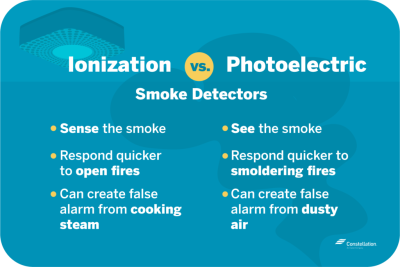
Deciding Between two Types of Smoke Alarms
The two most commonly recognized smoke detection technologies are ionization smoke detection and photoelectric smoke detection.
- Ionization smoke detection is generally more responsive to flaming fires. Ionization-type smoke alarms have a small amount of radioactive material between two electrically charged plates, which ionizes the air and causes current to flow between the plates. When smoke enters the chamber, it disrupts the flow of ions, thus reducing the flow of current and activating the alarm.
- Photoelectric smoke detection is generally more responsive to fires that begin with a long period of smoldering (called “smoldering fires”). Photoelectric-type alarms aim at a light source into a sensing chamber at an angle away from the sensor. Smoke enters the chamber, reflecting light onto the light sensor; triggering the alarm.
Acceptable Performance
For each type of smoke alarm, the advantage it provides may be critical to life safety in some fire situations. Home fatal fires, day or night, include a large number of smoldering fires and a large number of flaming fires. You can not predict the type of fire you may have in your home or when it will occur. Any smoke alarm technology, to be acceptable, must perform acceptably for both types of fires in order to provide early warning of fire at all times of the day or night and whether you are asleep or awake.
Sufficient Escape Time
The best evidence has always indicated that either type of smoke alarm will provide sufficient time for escape for most people for most fires of either smoldering or flaming type. However, research is ongoing, and standards are living documents. If at any time, research points to a different conclusion, then that will lead to proposals for changes in the NFPA standard or the closely related Underwriters Laboratories standard for testing and approving smoke alarms. Both organizations currently have task groups looking at smoke alarm performance in the current home environment.
Using Both Alarms
For best protection, it is recommended both (ionization and photoelectric) technologies be in homes. In addition to individual ionization and photoelectric alarms, combination alarms that include both technologies in a single device are available.
Fire Statistics
Almost all households in the U.S. have at least one smoke alarm, yet in 2003-06, smoke alarms were present in only two-thirds (69 percent) of all reported home fires and operated in just under half (47 percent) of the reported home fires. (“Homes” includes one- and two-family homes, apartments, and manufactured housing). Forty percent of all home fire deaths resulted from fires in homes with no smoke alarms, while 23 percent resulted from homes in which smoke alarms were present but did not operate.
Death Rate
The death rate per 100 reported fires was twice as high in homes without a working smoke alarm as it was in home fires with this protection. Hardwired smoke alarms are more reliable than those powered solely by batteries.
Source
These estimates are based on data from the U.S. Fire Administration’s National Fire Incident Reporting System and the National Fire Protection Association’s annual fire department experience survey.
